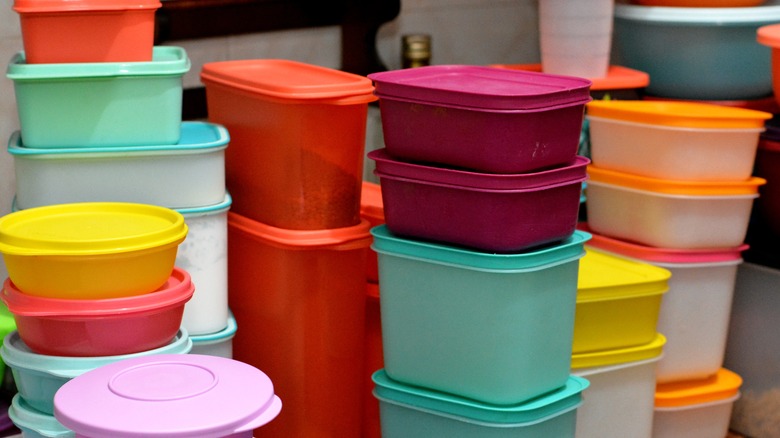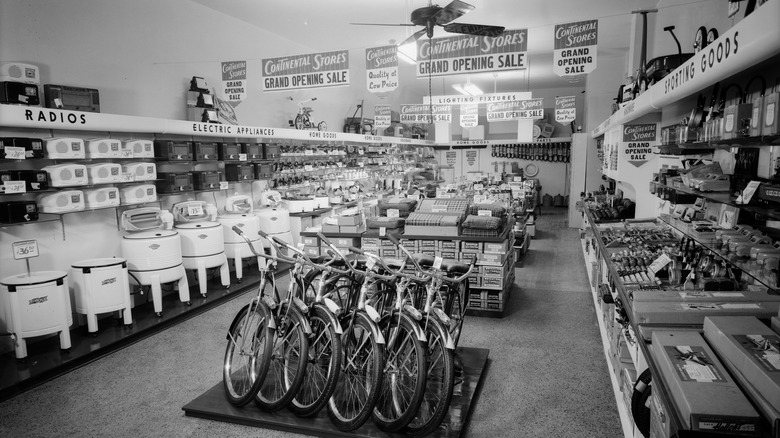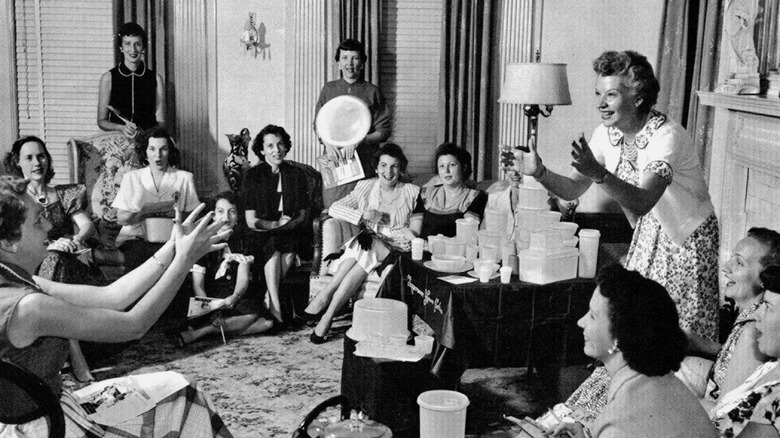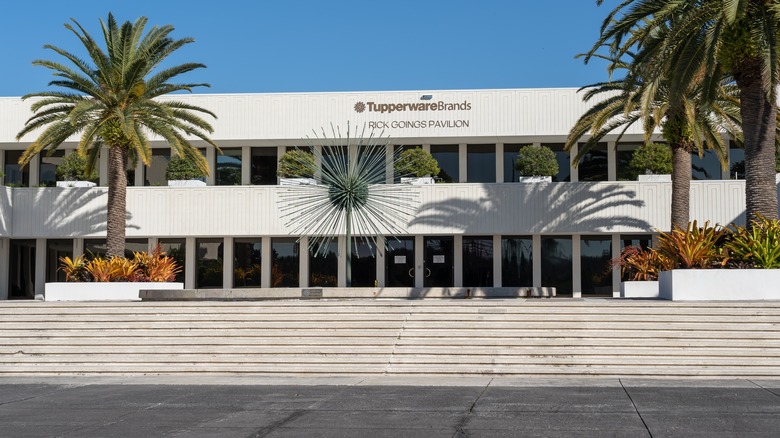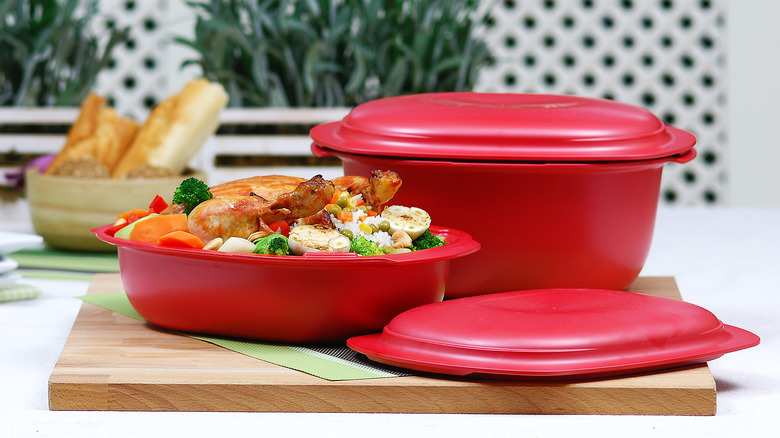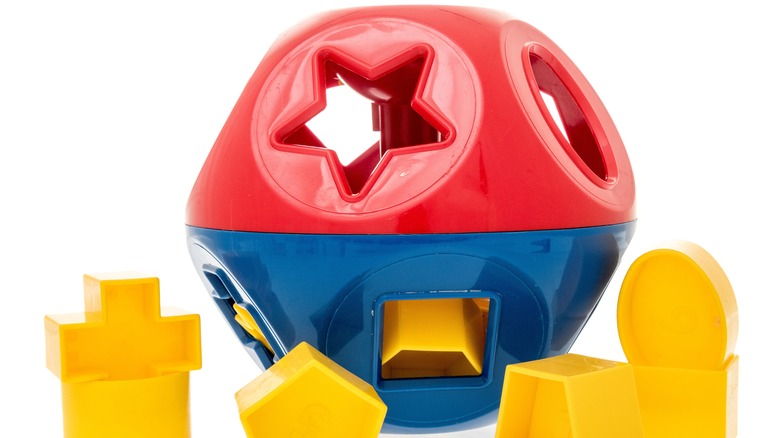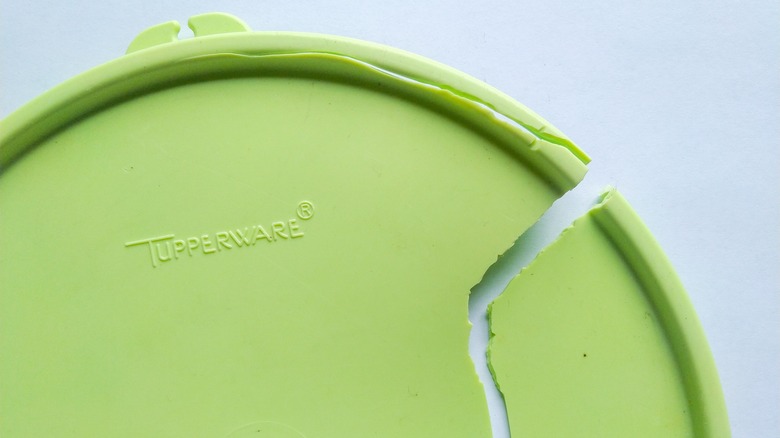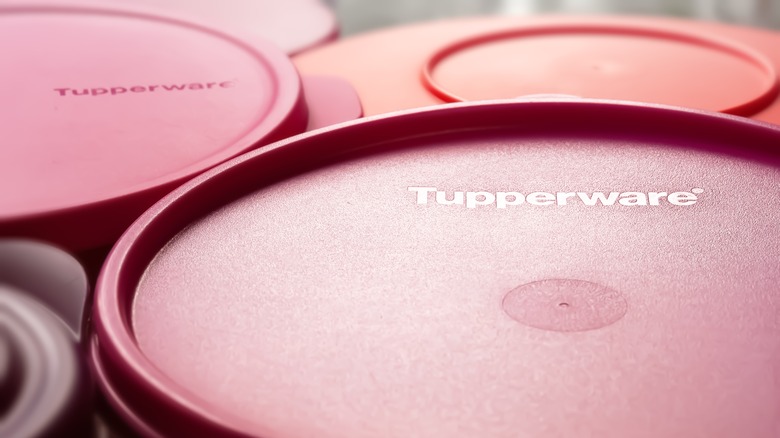The Rise And Fall Of Tupperware
Tupperware has become such a big part of people's lives that it's hard to imagine storing and transporting food without it. The brand has even reached the apex of fame by becoming synonymous with plastic food storage containers — regardless of what brand actually made them. This is only fitting since Tupperware isn't just found in kitchens; it's also in museums like the Smithsonian. The downside of this (at least from a business perspective) is that the general public considers the brand to be interchangeable with its competitors. In fact, some people may not even realize that the Tupperware brand exists.
This is one of many issues that the Tupperware brand faces today as it slides toward bankruptcy. If you know its history, you may be wondering if this will be its permanent downfall or if it will rise again. Since its invention nearly 80 years ago, the story of Tupperware — or more precisely, the Tupperware brand — has been filled with ups and downs. From its inspired invention to the wild popularity of Tupperware parties to its expansion across dozens of countries to its ongoing financial troubles, let's take a look at the highest and lowest points in Tupperware's history.
The invention of Tupperware
The official date of Tupperware's invention is generally cited as 1946, the year it was first released onto the market. Even so, Earl Tupper — the brand's namesake and inventor — took quite some time to develop his now-iconic product. Prototypes were even around back in the 1930s, although the public wouldn't come to know the containers with the burp-able lid until at least a decade later.
Like fellow 20th-century food industry innovator Colonel Harland Sanders of KFC fame, Tupper tried his hand at a series of jobs before finding the one that would make him famous — and change the world of food storage as we know it. In the 1930s, Tupper was working at a plastics factory when he began experimenting with different variants of the substance. He ultimately created a plastic compound unlike any other.
In its early days, plastic was brittle and smelly. Tupper's version was odorless, durable, and non-porous. The inventor, who was inspired by the way paint cans seal shut, used this new plastic and an innovative lid design to create food storage containers that had all of these qualities. They were also air- and water-tight. Before long, Tupper was ready to release his first Tupperware products into stores.
Tupperware fails in stores
In 1946, the first two Tupperware products were sent to stores: the Bell Tumbler and the Wonderlier Bowl. These products are now so famous that the Smithsonian even has examples of them in its permanent collection. No one could have imagined this at the time, however. Instead of giving Tupperware a warm welcome, consumers were thrown off by the concept. For one thing, they didn't associate plastic with food storage. This was because, at the time, plastic was known for being smelly and brittle. Instead, people continued storing food as they had for decades (or even centuries): in ceramic or glass containers, tins, and paper packaging.
Even those who were willing to give Tupperware a try identified another obstacle: the resealable lid. Although plastic food containers with airtight lids are everywhere today, believe it or not, they weren't intuitive for consumers in the 1940s. All of this meant that instead of being stacked in people's refrigerators, Tupperware containers sat on store shelves.
The invention of the Tupperware party
Even if you've never bought Tupperware, you've probably heard of Tupperware parties. These events, in which a saleswoman would host a party at her home and demonstrate different Tupperware products in order to sell them, became an iconic part of suburban life in the 1950s and '60s.
Despite these parties' fame, it's unclear exactly when the first one was held, though we do know who held it: Brownie Wise, a single mother and former saleswoman for Stanley, developed the sales technique and used it to sell Tupperware starting in the late 1940s. Earl Tupper, surprised by Wise's success, hired her. The company quickly realized that if consumers could touch and smell Tupperware products — not to mention see how the company's resealable lids worked ("burping," or opening the lid and hearing the air come out, became a staple of Tupperware demonstrations) — they'd start buying.
Tupperware turned its back on stores and began selling its products exclusively through Tupperware parties. Rather than hiring primarily male salespeople, the company opted for women, who were, at the time, responsible for buying home goods and who could connect with other women. In hindsight, Tupperware changed women's lives in two ways: by making food storage easier and by giving them a flexible way to earn money through commissions.
Earl Tupper and Brownie Wise leave the company
Once Tupperware figured out how to market and sell its products, it found huge success. At first, Earl Tupper and his board of directors knew that this was largely thanks to Brownie Wise, whom they had made a vice president of the company. Wise's success story and ingenuity made her the face of Tupperware. In 1954, she was the first woman to be featured on the cover of Business Week magazine. In 1958, however, at the height of the company's success, Tupper decided to sell the business. This may have been because he wanted to avoid tax penalties his family would incur upon his death. Many business owners have workarounds for this, however, so it's also possible that Tupper simply wanted to retire. After selling his company to the Rexall Drug Company (known today as Dart Industries) for $16 million, he eventually set sail for Costa Rica.
Unfortunately, Wise didn't enjoy the same lavish fate. Many historians believe Tupper, a quiet man, was jealous that Wise was the person most associated with Tupperware, even though he was its inventor. By the time he left, Tupper had fired Wise. Sadly, while Tupper moved on to a luxurious retirement, Wise never fully benefited from the success she'd brought to the company. Though she continued to work as a consultant and held other positions, she never reached the same level of professional glory.
Tupperware goes overseas
In the 1960s, Tupperware's new owner, Rexall Drugs Corporation, decided to expand Tupperware beyond the American market. The products quickly became a success overseas and were sold in dozens of countries, often through in-person sales techniques like Tupperware parties.
In addition to sales figures, Tupperware's international success is apparent in two ways. First, while "Tupperware" first became a generic term for plastic food storage containers in the U.S., the same can also be said for a number of other countries, from France to Peru. Beyond this, there was another surprising indicator of how much Tupperware had become a part of life around the world — even in the upper echelons of society. In the early 2000s, an undercover reporter discovered that Queen Elizabeth II stored her breakfast cereal in Tupperware containers. Today, despite far lower sales than it had in its heyday, Tupperware is still sold in over 80 countries worldwide.
Tupperware branches out to toys
The 1960s ushered in another big change for Tupperware. The company continued to produce food and drink-storage products, but it also started putting its plastic to use in other ways. One was to transition from food storage into food serving with more decorative food-related items like the Carousel Caddy, a circular, two-tiered tray that held drinks and snacks.
The company also branched out into the toy market. Tupperware has released several toys over the years, but its best-known is likely the Shape-O Toy. First released in the 1970s, the Shape-O Toy is a bright plastic ball with cutouts that correspond to yellow plastic shapes. The colorful plaything is still sold today.
In the decades since, Tupperware has developed other, even less-expected products. In the 2010s, for instance, it began producing filtration and water storage systems. It has also developed a device called PONDS (Passive Orbital Nutrient Delivery System) that helps vegetables grow in space. It has been used by the likes of NASA and SpaceX.
Earl Tupper's patents expire
Several of Tupperware's patents expired in the 1980s, and the company's founder, Earl Tupper, died in 1983. Suddenly, Tupperware was sharing the market with countless rivals, from off-brand plastic food storage containers that didn't even feature hermetic seals to major players like Rubbermade and Glad. Even though Tupperware products are high-quality, they're also among the most costly options on the market, leading many people to cheaper alternatives, especially in times of recession. In fact, Reuters reported in 2023 that one of the company's biggest rivals has become the reusable plastic takeaway containers provided by some restaurants. Consumers can order food at these establishments and receive a free container — a much better deal than paying top price for just the container itself.
That said, many consumers may not even realize that Tupperware-brand food storage containers are an option. Because the name has become a catch-all term, it's not always recognized as its own brand and product line. NPR correspondent Alina Selyukh witnessed this in a powerful way when she visited the Smithsonian in 2023 to see the Tupperware products on display. She observed that teenagers on a school trip were surprised that Tupperware wasn't just the generic name for similar containers.
The first virtual Tupperware parties
For years, the Tupperware party sales technique seemed like a sure bet. Starting in the 1970s and '80s, however, fewer women were selling Tupperware or attending parties because they had joined the workforce full-time.
Then, in the 2010s, Tupperware parties and sales went virtual. Over time, sellers began experimenting with online gatherings on platforms like Facebook, Zoom, Instagram, and TikTok. Like at traditional, in-person Tupperware parties, these hosts usually demonstrate the products (often by using them while cooking) and encourage attendees to participate in games.
These virtual parties are distinct from their predecessors, however. Some are comprised only of text messages and photos. Tupperware approves of and encourages virtual Tupperware parties, as well as selling on social media. For instance, Tupperware's India-based website offers social media Tupperware salespeople their own link to an official sales page. Real-life Tupperware parties haven't entirely disappeared, though. For instance, Tupperware's U.S. website offers advice and even gifts for salespeople who want to host or take part in a live gathering.
Tupperware nearly goes bankrupt
If you've seen Tupperware in the news lately, it's probably not because of a new product or innovation, and it likely wasn't an invitation to a virtual Tupperware party. Despite its household name, the company has been in financial trouble. Its sales have declined over the past decade, and a Statista report revealed that the company's 2022 sales figures were 50% lower than those from 2013. Even before this noticeable dip, Tupperware had to make some adjustments. For instance, despite Queen Elizabeth II using its products, Tupperware stopped direct sales in the U.K. market in 2003.
One contributor to this downward trend is that glass containers have been rising in popularity as consumers become more environmentally conscious. Add to this an increase in the cost of the raw materials Tupperware uses to make its products, and the company's future looks rather bleak. While there was an uptick in Tupperware sales during the pandemic, as more people were cooking at home and needed a way to store leftovers, this success was merely a blip. In 2023, the company was in danger of having to declare bankruptcy.
Tupperware's uncertain future
As of April 2024, Tupperware is still likely to go bankrupt. While some experts criticize Tupperware for not adapting to changing times, this hardly seems fair considering the company's recent innovations, from implementing virtual Tupperware parties to partnering with NASA. Tupperware has even begun selling in real-life and online stores. In the U.S., for instance, you can find some Tupperware products at Target. Folks who want to forego real-life shopping or Tupperware parties (virtual or otherwise) can opt to buy the company's products through its online store or Amazon.
So, why isn't Tupperware more successful? NPR correspondent Alina Selyukh's theory seems to make the most sense: "The company name outgrew the company." Because "Tupperware" has become a general term for food storage containers, consumers may not recognize it as an actual brand or know where to find it. Others may have preconceived notions about what Tupperware was rather than what it has become. For instance, environmentally conscious consumers may not know that Tupperware's products have been BPA-free since the 2010s, or that the company has a recycling program for its old containers.
While sales of new Tupperware products continue to fall, vintage Tupperware is popular on eBay (although the company's old containers may not be entirely safe, as they contain BPA and other chemicals). This ongoing interest in Tupperware may just prove that all is not lost.
